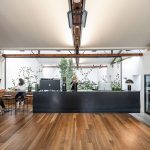Coco Republic: Look at Auckland’s new showroom
Retail design has become a very specialized discipline due to the heavy demands placed on retail space. The primary purpose of retail space is to stock and sell products to consumers, the spaces must be designed in a way that promotes an enjoyable and hassle-free shopping experience for the consumer. Retail spaces, especially when they form part of a retail chain, must also be designed to draw people into the space to shop.
Retail design first began to grow in the middle of the 19th century, with stores such as Bon Marche and Printemps in Paris, “followed by Marshall Fields in Chicago, Selfridges in London and Macy’s in New York.” The first known chain department stores were established in Belgium in 1868, when Isidore, Benjamin and Modeste Dewachter incorporated Dewachter frères (Dewachter Brothers) selling ready-to-wear clothing for men and children and specialty clothing such as riding apparel and beachwear.
The next evolution of retail design was the creation of the boutique in the 1960s, which emphasized retail design run by individuals. Some of the earliest examples of boutiques are the Biba boutique created by Barbara Hulanicki and the Habitat line of stores made by Terence Conran.
With heavy foot traffic maintenance for commercial spaces is important to keep the stores looking clean and inviting. Regular maintenance of commercial spaces is not difficult, some guidelines to follow on timber floors are: Dirt traps when entering shopping centres or retail shops need to be monitored. It is recommended to wipe spills up as soon as possible to avoid staining. Use of felt pad protection for chairs and furniture that has repetitive motions. Vacuuming regularly using the brush attachment to remove dust. Clean with WOCA products or non abrasive/ chemical free cleaning products. Avoid using steam mops, wet mopping the floors and do not use bleach. Upkeep of wooden floors in areas of high volume traffic can be revitalised periodically using a more intense cleaner and refresher, as recommended by the flooring manufacturer.

Materiality needs to be considered as a selling tool, the choices made must not only be aesthetically pleasing and persuasive but also functional with a minimal need for maintenance. Retail spaces are high traffic areas and are thus exposed to a lot of wear this means that possible finishes of the materials should be durable. The warmth of a material will make the space more inviting, a floor that is firm and somewhat buoyant will be more comfortable for that consumer to walk on and thus this will allow them to take longer when exploring the store. With this in consideration, Coco Republic selected Plank Gris for their showroom roll out.




